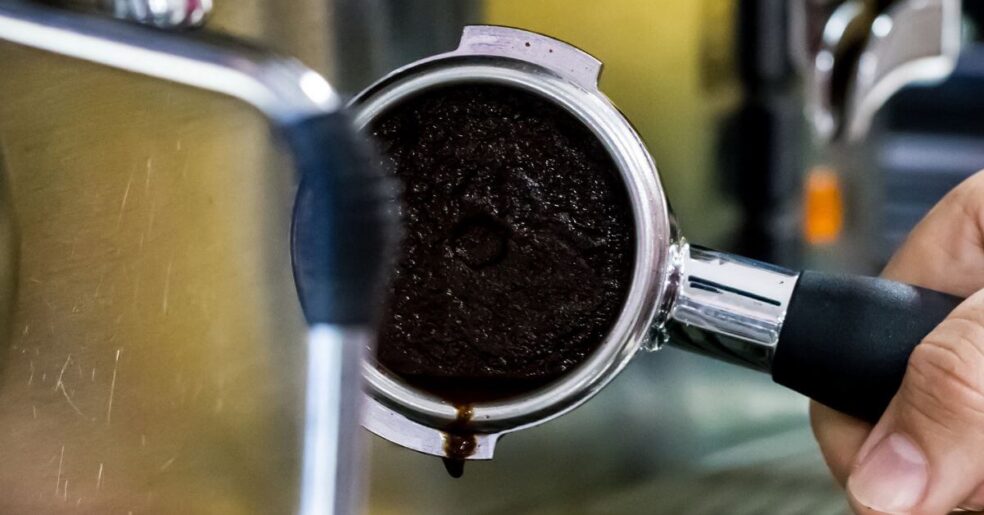After pulling a shot of espresso, you hope that a firm espresso puck pops out of your portafilter, but sometimes this isn’t the case. Why do espresso pucks sometimes turn out wet and soggy?
There are a number of reasons this could happen, but fortunately, a wet espresso puck doesn’t necessarily mean your shot of espresso is bad.
However, if you’re still curious as to why this happens, keep reading! We’re about to talk about the top 6 reasons for wet espresso pucks and what you can do about it!
FYI: If you’re in the market for a great espresso machine, we’d recommend the Breville Barista Express. We bought ours a while back and we love it! (Link goes to Amazon.)
Incorrect Dosing Can Cause A Wet Espresso Puck
Dosing refers to the amount of coffee grounds you put in the portafilter. If you use too few coffee grounds, they may become oversaturated with water during the brewing process. This can result in a watery or soggy puck.
To prevent this, you’ll typically want to use between 7-9 grams of coffee for a single shot of espresso, and anywhere from 18-21 grams for a double shot.
To make sure you’re dosing correctly, a scale is an absolute must. If you don’t have one, a good option is the Hario Scale and Timer (link goes to Amazon).
Using the right amount of coffee will not only help you avoid a wet espresso puck but will also help prevent over-extracted coffee.
But keep in mind that just because your puck is wet doesn’t mean that your espresso is bad.
Your Grinds Are Not Evenly Distributed In The Portafilter
When you pour coffee grinds into a portafilter, they don’t automatically distribute themselves evenly. Typically, there’s a mound of coffee in the middle of a portafilter.
There are some areas where the grinds are more packed together and other areas where the grinds are less dense.
If you put the portafilter in the machine without evenly distributing the grinds first, the water would concentrate in the areas with fewer grinds (this is called channeling).

As a result, your espresso puck might be wet and over-extracted in some areas and relatively dry and under-extracted in others.
There are a few ways to level off your coffee:
- use your fingers
- use a leveler and hand tamper (link goes to Amazon)
- use a WDT tool (link goes to Amazon)
The hand tamper we’ve linked to above fits 54mm portafilters that are common in Breville espresso machines. If you decide to buy a hand tamper, make sure you get the right size for your particular machine.
FYI: A Weiss Distribution Technique (WTD) Tool is a method that uses thin needles to stir coffee grounds while they’re in a portafilter. The purpose is to break up clumps and create uniform density to create more even extractions. (read more about WTD on Daily Coffee News)
Your Grind Size Is Not Consistent
If your grinder doesn’t grind beans uniformly, you can also end up with a wet espresso puck.
This happens because it’s easier for water to flow through coarser grinds than finer grinds. So, the water will channel in areas with coarser grinds and be stagnant in areas with finer grinds.
Many espresso machines, like the Breville Barista Express (link to Amazon), have built-in burr grinders. So, inconsistent grinds won’t be a big issue if you have a machine like this.
However, if your espresso machine doesn’t have a built-in grinder, look into getting a burr grinder like the OXO Conical Burr Grinder (link goes to Amazon).
Another thing to keep in mind is that your beans may be inconsistent if you recently changed the setting on your grinder. For example, if you just changed your grind setting from 14 to 8, beans that are already inside the grinder may still be ground at the old setting.
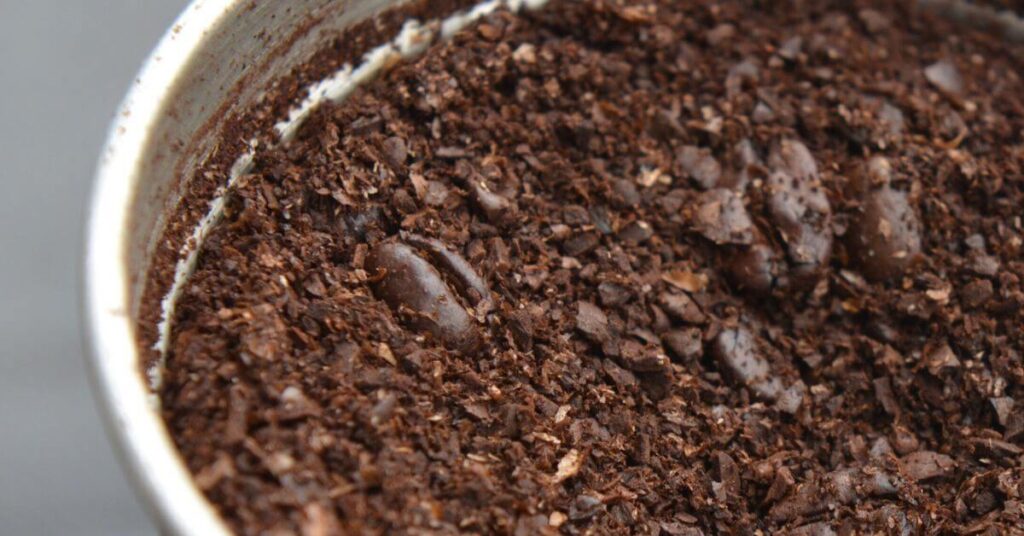
Related Posts:
- Breville vs De’Longhi: Best Espresso Machines 2023!
- Does Espresso Break A Fast? Must Know Facts!
- Does Espresso Have Milk A Simple (But Complete) Guide
The Roast Of Your Coffee Bean
Even the roast of your coffee bean can affect how wet your coffee puck is. Darker roast beans are more fragile, more porous, and easier to extract solubles from. By comparison, lighter roasts are harder, denser, and more difficult to extract from.
This means that some beans absorb water and become saturated easier than others. Depending on which beans you prefer, your espresso puck may be wetter or drying than someone else’s.
But keep in mind that a wet espresso puck doesn’t necessarily mean you did something wrong. How your espresso tastes is the most important.
There Are Air Pockets In Your Coffee Grounds
There’s a chance that air pockets could form as you pour the grinds in your portafilter. If this happens, water could pool in the air pocket and result in a wet espresso puck.
To prevent this from happening, you can use a WDT tool to distribute the coffee evenly in the portafilter. Tamping with a standard tamper or a hand tamper will also help force out any air pockets (both links go to Amazon).
If you decide to buy a hand tamper, be sure to get the right size for your portafilter. The one we’ve linked to above is 54mm, which is the typical size for Breville machines.
Your Machine Doesn’t Have A 3-Way Valve
A 3-way solenoid valve removes pressure from the group head after you pull your shot of espresso. This depressurization can remove excess water from the espresso puck.
So, if your machine has the valve, your espresso pucks will usually be dry and easy to remove. Without this valve, the puck can be wet and soupy.
Either way, the valve won’t affect the quality of your espresso.
Related Posts:
- How Much Caffeine Is In Two Shots Of Espresso?
- Best Espresso Machine Under 200 Dollars!
- Coffee Espresso Temperature. Here’s What To Do To Brew A Unique Cup!
Why Is My Espresso Puck Wet? Key Takeaways
There are a number of reasons your espresso puck may come out wet and soggy, but this doesn’t mean your espresso is bad.
More often than not a wet espresso puck has something to do with your grinds. Either how much you use, whether they’re too coarse or fine, or if they were distributed and tamped. Play with these variables and see if there’s a difference!
Cheers Coffee Lovers!

KEEP READING
- Is Arabica Or Robusta Best For Cold Brew Coffee?

- Why Is My Espresso Puck Wet? (The 6 Most Common Reasons)
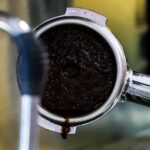
- How To Make Cuban Coffee Without A Moka Pot? (3 Options!)

- Does Cold Brew Break A Fast? Things To Consider!

- Can I Use Coffee Grounds Twice? (Here Are Our Results!)

- What’s The Best Grind Size For A Moka Pot? Ultimate Guide!

- Does Espresso Have Milk? A Simple (But Complete) Guide

- Can I Use A French Press With Pre-Ground Coffee? Pros And Cons
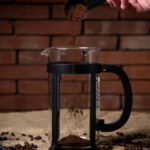
- How Much Caffeine Is In Two Shots Of Espresso?

- Can You Brew Coffee With Milk? (4 Methods That Will Work!)

- Can You Make Cold Brew Coffee With Milk Instead Of Water?

- Can You Use Milk In A Moka Pot? (Here Are Our Results!)
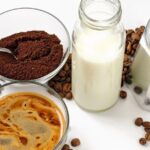

Oliver is co-owner of Coffee Break Lovers. The only thing he loves more than the process of brewing coffee is drinking it.

